BalticWay project
The BalticWay project is a part of the BONUS activities. This framework of cooperation brings together the research communities of marine, maritime, economical and societal research to address the major challenges faced by the Baltic Sea region. Research in this framework is funded jointly by the marine research funding agencies in the nine Baltic Sea countries countries together with the European Union.
The research proposal
BalticWay: The potential of currents for environmental management of the Baltic Sea maritime industry
has been proposed by a consortium of 8 research groups from 6 Baltic Sea countries.
See a short overview of the BalticWay ideas and developments in BONUS in Brief, November 2011, p. 7
Outline of key results achieved in the BalticWay cooperation: BONUS Briefing No 7, October 2011: BalticWay
The proposal aims at a substantial decrease of marine–industry–induced environmental risks and impacts on bio–diversity, particularly on fragile ecosystems. The core objective is to develop a scientific platform for an innovative low–cost technology of environmental management of shipping, offshore, and coastal engineering activities. The technology will be applied to place dangerous activities in areas, an accident in which will have a minimum threat to vulnerable areas.
Our approach makes use of the existence of semi–persistent current patterns that considerably affect the properties of pollution propagation: the probability of transport of dangerous substances from different open sea areas to the vulnerable areas is largely different. For certain regions (areas of reduced risk) this probability is relatively small.
The location of areas of reduced risk will be established numerically and verified experimentally. A combination of the classical risk analysis with novel mathematical methods (such as inverse methods) will be applied to identify the persistence, properties, and potential effect of such areas, and to establish generic criteria for their existence. Based on existing results, we concentrate on the Gulf of Finland and the Darss Sill.
As a first step we consider the consequences of current–induced propagation of oil spills released from ships, aiming to route ships along the least dangerous paths, much like dangerous transports on land follow predefined routes.
Coordinator:
Tarmo Soomere, Institute of Cybernetics at Tallinn University of Technology
Partners:
Finnish Environmental Institute (Helsinki);
Department of Meteorology, University of Stockholm,
Swedish Meteorological and Hydrological Institute (Norrköping),
Danish Meteorological Institute (Copenhagen),
Institute for Coastal Research, Helmholtz–Zentrum Geesthacht,
Leibniz Institute of Marine Sciences at the University of Kiel,
Laser Diagnostic Instruments (Tallinn)
- BalticWay ANNUAL MEETING 18–20 March 2010
- BalticWay Second Annual Meeting 10–13 April 2011 Welcome to the meeting by Andrea Giudici
- BalticWay summer school “Preventive methods for coastal protection” (Klaipeda, 18–20 September 2011)
| BalticWay summer school | Draft timetable |
Lecture notes : Kai Myrberg |
BalticWay results presented at international conferences:
BalticWay information:
|
Synopsis.
|
|
Highlights
|
- D4.3. The effect of local wind and waves on the areas of reduced risk: Manuscript of a chapter to the book Preventive Methods for Coastal Protection: The Use of Ocean Dynamics for Pollution Control
- D4.4. Areas of reduced risk associated with favourable subsurface current patterns: Submission to Boreal Environment Research
- D6.1. Mathematical background of the concept of areas of reduced risk: Submission to Journal of Marine Systems
- Final Report & Project year 3 January–December 2011
|
Highlights
|
Manuscript on surface-drifter observations in the Baltic Sea
